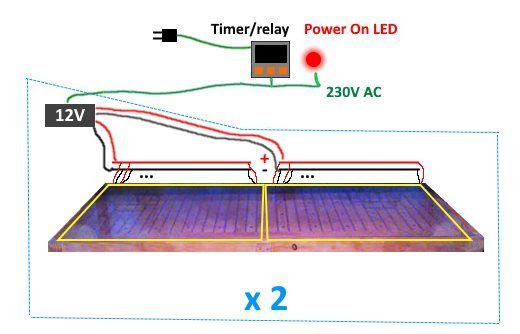The exact parts we used on the electrical side were as follows:
AliExpress:
- 9 x
5m Infrared LED strips ($53 x 5)
Conrad.fr:
-
Red LED indicator light (2€)
-
Muller countdown timer/relay (55€)
- 2 x
12V 12.5A DC power supplies (79€ x 2)
- Box of
Wago quick connectors (29€)
The general wiring diagram is like so:
The LED strips are supposed to be 12V, 2A for 5m. They can be cut every 5cm, and every 5cm includes 3 LEDs and one current-limiting resistor. This means that if one LED dies, in the worst case only 2 other LEDs will die along with it - instead of a whole strip.
Anyway, one 5m strip actually consumes 12V, 1.24A per 5m (not 2A as stated). When you cut the sections shorter to 60cm as we did, each strip uses just under 200mA.
So that means each 60cm strip is ~0.2A, or 1.67A per 5m since there are less losses when the strips are cut shorter (which is good).
For wire, there are two 12V +/- rails consisting of 1.5mm2 solid copper wire. Unless otherwise noted, all the wire was 1.5mm2. Each of those 2 rails is connected to one of the +/- outputs of one 12V power supply. The 12V supplies have 4 wires on the DC output: two +12V, and two 0V/ground. So one 12V AC->DC converter powers the two sections of the top panel, and the other 12V supply powers the two sections of the bottom panel.
The 12V supplies are rated at 12.5A max, but it's a bad idea to drive them hard (too much heat = shorter life). Since it turns out that the strips use less power than claimed (very common), each section consumes:
0.2A per strip x 18 strips per section = 3.6A
Since each 12V supply powers 2 sections, each 12V supply is outputting 7.2A out of 12.5A rated max.
Naturally, this was all measured very carefully!

This gives a power consumption of 86.4W per panel, or 172.8W total.
Be aware that if you buy a ready-made infrared LED lamp off Amazon, the power ratings are greatly exaggerated as usual. The
6W infrared spotlights we got earlier each consumed only 3W, and about half of that power is actually being turned into infrared light if you're lucky! So, your "6W" infrared spotlight is only spitting out about 1.5W worth of actual infrared light.
To connect the rails to each individual LED strip, we used wires from inside a PTT-298 phone cable (ADSL-approved!) because the wires inside the phone cable are solid and 0.5mm2, and they are very strong. They won't break if bent. They're also easy to solder to the tiny pads on the LED strips.
Each LED strip was soldered to two 0.5mm2 wires (12V and ground) about 15cm in length. After sticking the 2 wires through the holes, each pair of wires was then soldered to the 1.5mm2 12V rails for that section (each rail was about 80cm in length of stripped wire). That works out to 288 solder joints.
0.5mm2 is oversized for 0.2A of current, and 1.5mm2 wire is oversized for 3.6A of current. But it's what we had on hand, and overkill is usually good. Even with a few meters of wire running from the top panel down to the undersize of the bottom panel where the DC supplies are located on the shelf, the voltage at each strip was a perfect 12.0V.
Note that you CAN buy connectors for the end of LED strips like these, but they are both relatively expensive and clunky. They wouldn't have fit underneath the plexiglass cover. So, there was a lot of wire stripping and soldering done instead.
The 230V timer comes with instructions and is easy to connect. The timer is also a relay that just turns the live wire on/off from the wall socket, and the AC output then powers both 12V supplies and the 230V, 20mA red LED light. Since the infrared LEDs glow VERY dimly red in the visible spectrum, it's hard to tell the thing is on. So the red LED is the Power On Light.
The Wago quick connectors/dominoes are just to make life simpler, since some of the 1.5mm2 wire we used was stranded copper, and some was solid. The cables between the top and bottom panels were stranded so they wouldn't break when opening and closing the top panel repeatedly.
So, yeah. If you want to build your own, you're gonna need some woodworking skills, and some electronic skills, and a lot of patience!









